Alfa Romeo: Difference between revisions
m Reverted edits by 81.145.240.153 to last version by EmxBot |
|||
| Line 99: | Line 99: | ||
With the imposition of sanctions by western powers in the 1970s and 1980s, South Africa became self sufficient, and in car production came to rely more and more on the products of the Uitenhage factories. In consequence, production levels increased, and many manufacturers including [[Fiat]] Spa., [[Lancia]], [[Ferrari]] and Alfa Romeo transferring all their right-hand drive production to Uitenhage. [[Volkswagen]] AG, [[Daimler Benz]] AG and [[BMW]] AG followed suit at about this time. |
With the imposition of sanctions by western powers in the 1970s and 1980s, South Africa became self sufficient, and in car production came to rely more and more on the products of the Uitenhage factories. In consequence, production levels increased, and many manufacturers including [[Fiat]] Spa., [[Lancia]], [[Ferrari]] and Alfa Romeo transferring all their right-hand drive production to Uitenhage. [[Volkswagen]] AG, [[Daimler Benz]] AG and [[BMW]] AG followed suit at about this time. |
||
Alfa Romeo no longer produces cars in South Africa. |
|||
Since then, all right-hand-drive production of Alfa Romeo (and most other European manufacturers) remains in Uitenhage - so that RHD European cars are actually South African in origin, or else have their steering and dashboard assemblies produced there. |
|||
Recently (1989), Alfa Romeo has moved their car production to districts within Italy. The Pomigliano d’Arco plant produces the 155, which is followed by the 145 and the 146, while Arese witnesses the creation of the thrilling new Spider and GTV. 1997 is the year of the 156, which in 1998 is voted “Car of the Year”. 1998 sees the launch of the new flagship, the 166. Which takes us to 2000, to the threshold of the third millennium, and the 147, which wins the prestigious title of “Car of the Year 2001”. |
Recently (1989), Alfa Romeo has moved their car production to districts within Italy. The Pomigliano d’Arco plant produces the 155, which is followed by the 145 and the 146, while Arese witnesses the creation of the thrilling new Spider and GTV. 1997 is the year of the 156, which in 1998 is voted “Car of the Year”. 1998 sees the launch of the new flagship, the 166. Which takes us to 2000, to the threshold of the third millennium, and the 147, which wins the prestigious title of “Car of the Year 2001”. |
||
Revision as of 07:25, 4 April 2007
This article's tone or style may not reflect the encyclopedic tone used on Wikipedia. |
| Alfa Romeo Corporate logo | |
| Company type | Since 1986 a subsidiary of Fiat S.p.A. |
|---|---|
| Industry | Automotive |
| Founded | 24 June 1910 in Milan |
| Headquarters | |
Key people | Luca di Montezemolo - President Antonio Baravalle - CEO |
| Products | 147 159 166 Brera Spider GT 8C Competizione |
| Website | http://www.alfaromeo.com/ |
Alfa Romeo is an Italian automobile manufacturer founded in 1910. Alfa Romeo has been a part of the Fiat Group since 1986. The company was originally known as ALFA, which is an acronym for Anonima Lombarda Fabbrica Automobili (translated: Lombard Automobile Factory, Public Company). (First logo: [1]).
History
Foundation and early years
The company that became Alfa Romeo was founded as Società Anonima Italiana Darracq (SAID) in 1906 by Cavaliere Ugo Stella, an aristocrat from Milan, in partnership with the French automobile firm of Alexandre Darracq. The firm initially produced Darracq cars in Naples, but after the partnership collapsed Stella and the other Italian co-investors moved production to an idle Darracq factory in the Milan suburb of Portello, and the company was renamed A.L.F.A (Anonima Lombarda Fabbrica Automobili). The first non-Darracq car produced by company was the 1910 24 HP, designed by Giuseppe Merosi. Merosi would go on to design a series of new ALFA cars with more powerful engines (40-60 HP). ALFA also ventured into motor racing, drivers Franchini and Ronzoni competing in the 1911 Targa Florio with two 24 HP models. However, the onset of World War I halted automobile production at ALFA for three years.
1916 saw the company come under the direction of Neapolitan entrepreneur Nicola Romeo, who converted the factory to produce military hardware for the Italian and Allied war efforts. Munitions, aircraft engines and other components, compressors and generators based on the company's existing car engines, and heavy locomotives were produced in the factory during the war. When the war was over, Romeo took complete control of ALFA and car production resumed in 1919. In 1920, the name of the company was changed to Alfa Romeo with the Torpedo 20-30 HP becoming the first car to be badged as such. Giuseppe Merosi continued as head designer, and the company continued to produce solid road cars as well as successful race cars (including the 40-60 HP and the RL Targa Florio).
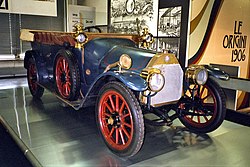

In 1923 Vittorio Jano was lured away from Fiat, partly thanks to the persuasion of a young Alfa racing driver named Enzo Ferrari, to replace Merosi as chief designer at Alfa Romeo. The first Alfa Romeo under Jano was the P2 Grand Prix car, which won Alfa Romeo the inaugural world championship for Grand Prix cars in 1925. For Alfa road cars Jano developed a series of small-to-medium-displacement 4, 6, and 8 cylinder inline power plants based on the P2 unit that established the classic architecture of Alfa engines, with light alloy construction, hemispherical combustion chambers, centrally-located plugs, two rows of overhead valves per cylinder bank and dual overhead cams. Jano's designs proved to be both reliable and powerful.
Enzo Ferrari proved to be a better team manager than driver, and when the factory team was privatised, it then became Scuderia Ferrari. When Ferrari left Alfa Romeo, he went on to build his own cars. Tazio Nuvolari often drove for Alfa, winning many races prior to WWII.
In 1928 Nicola Romeo left, with Alfa going broke after defense contracts ended, and in 1933 Alfa Romeo was rescued by the government, which then had effective control. Alfa became an instrument of Mussolini's Italy, a national emblem. During this period Alfa Romeo built bespoke vehicles for the wealthy, with the bodies normally built by Touring of Milan or Pininfarina. This was the era that peaked with the legendary Alfa Romeo 2900B Type 35 racers.
The Alfa factory (converted during wartime to the production of Macchi C.202 Folgore engines) was bombed during World War II, and struggled to return to profitability after the war. The luxury vehicles were out. Smaller mass-produced vehicles began to be produced in Alfa's factories beginning with the 1954 model year, with the introduction of the Giulietta series of berline (saloons/sedans), coupes and open two-seaters. All three varieties shared what would become the classic Alfa Romeo Twin Cam engine, initially in 1300cc form. This engine would eventually be enlarged to just under 2 liters (1962cc) and would remain in production through 1995.
Post war
Once motorsports resumed after World War II, Alfa Romeo proved to be the car to beat in Grand Prix events. The introduction of the new formula (Formula One) for single-seat racing cars provided an ideal setting for Alfa Romeo's tipo 158 Alfetta, adapted from a pre-war voiturette, and Giuseppe Farina won the first Formula One World Championship in 1950 in the 158. Juan Manuel Fangio secured Alfa's second consecutive championship in 1951. During the 1960s, Alfa concentrated on competition using production-based cars, including the GTA (standing for Gran Turismo Allegerita), an aluminium-bodied version of the Bertone-designed coupe with a powerful twin-plug engine. Among other victories, the GTA won the inaugural Sports Car Club of America's Trans-Am championship in 1966. In the 1970s, Alfa concentrated on prototype sports car racing with the Tipo 33, with early victories in 1971; eventually the Tipo 33TT12 gained the World Sportscar Championship in 1975.
By the 1970s Alfa was again in financial trouble. The Italian government bowed out in 1986 as FIAT bought in, creating a new group, Alfa Lancia Industriale S.p.A., to manufacture Alfas and Lancias. Models produced subsequent to the 1990s combined Alfa's traditional virtues of avant-garde styling and sporting panache with the economic benefits of product rationalisation, and include a "GTA" version of the 147 hatchback, the Giugiaro-designed Brera, and a high-performance exotic called the 8C Competizione (named after one of Alfa's most successful prewar sports and racing cars, the 8C of the 1930s).
In 2005 Maserati was bought back from Ferrari and brought under Fiat's full control. Fiat Group plans to create a sports and luxury division from Maserati and Alfa Romeo. There is planned strategic relationship between these two; engines, platforms and maybe dealers will be shared in some market areas.
In the beginning of 2007 Fiat Auto S.p.A. was reorganizated and four new automobile companies were created; Fiat Automobiles S.p.A., Alfa Romeo Automobiles S.p.A., Lancia Automobiles S.p.A. and Fiat Light Commercial Vehicles S.p.A. These companies are fully owned by Fiat Group Automobiles S.p.A.
The History of the Alfa Romeo Badge
In 1910 a draughtsman named Romano Cattaneo was given the job of coming up with a badge for a new Milan-based company, ALFA. The story goes that as he was waiting for a tram at the Piazza Castello terminus in Milan, he gained inspiration from the great Visconti family's red cross and serpent coat of arms emblazoned over the great door of Castello Sforzesco.
With the help of Giuseppe Merosi, a designer, his sketches incorporated both the City of Milan's emblem and that of the Visconti family in a circular motif, bordered by a dark blue metallic ring containing the inscription "ALFA - ROMEO" and "MILANO" separated by two Savoy dynasty knots.
After the victory of the P2 in the inaugural Automobile World Championship in 1925, Alfa added a laurel wreath around the logo.
The name "Milano", the hyphen and the Savoy knots were eliminated when ALFA opened the factory at Pomigliano d'Arco, Naples in early 1970s.
Racing history
Alfa Romeo has been always involved with motor racing. In the 1920s and 30s Alfa Romeo scored many of the most famous and prestigious races and motoring events like Targa Florio, Mille Miglia and Le Mans. Great succes continued with Formula 1, Prototypes, Touring and Fast Touring. Private drivers also entered some rally competitions, with fine results. Alfa Romeo have competed both as a constructor and an engine supplier, via works entries Alfa Corse, Autodelta and private entries. Today Alfa Romeo is active in different Touring car series and new Alfa Romeo 8C Competizione is planned to take part to Le Mans GT2 class in near future.[1]
Alfa Romeo in popular culture
In the 1960s Alfa Romeo became famous for its small cars and models specifically designed for the Italian police - "Panthers"
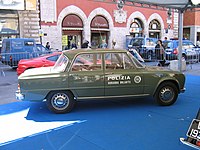
and Carabinieri; among them the glorious "Giulia Super" or the 2600 Sprint GT, which acquired the expressive nickname of "Inseguimento" (this car is wrongly supposed to be the one that the famous Roman police marshal and unrivalled driver Armandino Spadafora brought down on the Spanish Steps in 1960 while following some robbers - it was actually a black Ferrari 250 GT/E - this pic of Giulia [2], one of the dozens about this legend, is taken from a movie and not at the Spanish Steps).
Before being bought by Fiat, Alfa Romeo always had a daring commercial policy, constantly experimenting with new solutions and using them in its series production, even at the risk of losing market share. Alfa often used controversial and unorthodox styling too, which often challenged assumptions about styling.
In an English sales brochure:
- The Alfa Romeo Giulia 1600 SS - For the man who has everything, here is the car to keep him company. ... The price is GBP 2394.1.3 including tax. Expensive? Naturally! What else would you expect a hand-built Alfa to be? [3]
It represented those makes of cars that permitted sporty driving on common roads, provided the driver was enthusiastic enough to appreciate their particular "sound".
In Italian the owner of an Alfa Romeo is an "Alfista", and a group of them are "Alfisti". Alfa Romeo is sometimes worshipped by its owners, and many models have become cultural symbols [4]. There are many thriving Alfa Romeo owners clubs and Alfa Romeo Model Registers.
In 1967 the famous Dustin Hoffman film "The Graduate" gave worldwide unforgettable celebrity to the "Spider" (best known by the Italian nickname of "Duetto", or as "Osso di Seppia," meaning "cuttlefish bone," or Round-tail), and its unique shape [5]. The Spider was designed by Pininfarina; derived from several design studies dating back to the late 1950s, the Spider is believed to be the last design on which Battista Pininfarina personally worked.
Also James Bond (Roger Moore) used Alfa Romeo, exact model being GTV6. Film was 1983 Octopussy where he is pursued by two Bavarian BMW police cars.
In the television crime film series Ein Fall für Zwei ("a case for two", made so far over 200 episodes), the leading actor Claus Theo Gärtner, who plays the role of the private detective Josef Matula, uses always Alfa Romeo.
Production
Until the 1980s, Alfa Romeos, except for the Alfasud, were rear-wheel-drive.
According to the current Fiat CEO Sergio Marchionne in order to reap economies of scale, all new Alfa Romeo models will be made from the same basic platform (i.e., frame). Even Maserati will share components with some Alfas.[2]
Cloverleaf, or Quadrifoglio , badges denote variants of Alfa Romeo cars where the name denotes the high-end of the range in comfort and engine size, but previously denoted Alfa Romeo racing cars in the pre-Second-World-War era. The image first appeared in 1923 when Ugo Sivocci presented one prior to the start of the 14th Targa Florio as a good luck token to the team. This became the symbol of competition Alfas, denoting higher performance. Some modern Alfas wear a cloverleaf badge which is typically a green four leaf clover on a white background (Quadrifoglio Verde), but variants of blue on white have been recently observed as well.
The Alfettas of the early 1980s had models available sold as the "Silver Leaf" and "Gold Leaf" (Quadrifoglio Oro). These models were the top of the range. Badging was the Alfa Cloverleaf in either gold or silver to denote the specification level. The Gold Leaf model was also sold as the "159i" in some markets, the name in homage to the original 159.
The trim levels (option packages) offered today on the various nameplates (model lines) include the lusso ("luxury"), turismo ("touring"), and the GTA (gran tourismo alleggerita ("light-weight grand tourer"). The GTA package is offered in the 147 and 156 and includes a V-6 engine. In the past, Alfa Romeo offered a Sprint (from Italian sprintare, "to accelerate fast") trim level.
RHD production post-1960
In the 60s, the main Alfa Romeo seat was moved from inside Milan to a very large and nearby area extending over the municipalities of Arese, Lainate and Garbagnate Milanese. However, since then the Alfa seat is known to be in Arese, since the offices and the main entrance of the area are there.
In the late 1960s, a number of European automobile manufacturers established facilities in South Africa to assemble right hand drive vehicles for the Commonwealth markets. Fiat and other Italian manufacturers established factories along with these other manufacturers in Uitenhage, outside of Port Elizabeth in the Eastern Cape Province of South Africa.
With the imposition of sanctions by western powers in the 1970s and 1980s, South Africa became self sufficient, and in car production came to rely more and more on the products of the Uitenhage factories. In consequence, production levels increased, and many manufacturers including Fiat Spa., Lancia, Ferrari and Alfa Romeo transferring all their right-hand drive production to Uitenhage. Volkswagen AG, Daimler Benz AG and BMW AG followed suit at about this time.
Alfa Romeo no longer produces cars in South Africa.
Recently (1989), Alfa Romeo has moved their car production to districts within Italy. The Pomigliano d’Arco plant produces the 155, which is followed by the 145 and the 146, while Arese witnesses the creation of the thrilling new Spider and GTV. 1997 is the year of the 156, which in 1998 is voted “Car of the Year”. 1998 sees the launch of the new flagship, the 166. Which takes us to 2000, to the threshold of the third millennium, and the 147, which wins the prestigious title of “Car of the Year 2001”.
The 155 and GTV/Spider are no longer produced. The GTV/Spider was made in limited numbers, and are a sought after model.
The Arese factory today hosts almost nothing anymore and is almost abandoned. What remains are some offices and the great Alfa Romeo historical Museum, a must-see for Alfa Romeo fans.
Return to the United States
In 1995 Alfa Romeo ceased exporting cars to the United States. Rumors began of their return, however as the FAQ on Alfa's British website says "The long-awaited return of Alfa Romeo to the United States market should take place by 2007, with a range of new models." The models expected to come first in the United States were the Alfa Romeo 159, the Brera, the 8C Competizione, and the Spider, which were initially designed to pass US safety regulations.
Alfa Romeo's return to America was confirmed on May 5 2006 by Fiat CEO Sergio Marchionne. It will begin in 2008, by selling the 8C Competizione. Later, starting late 2009, Alfa Romeo will release the 159, Brera, and Spider after they receive a mid-life styling and technical refreshment. It is anticipated that a year or two later will see the introduction of the Kamal SUV, 169, and possibly the B-segment Junior. Alfa Romeos will be sold at Maserati dealers throughout America. [3]
Automotive
Current models

Alfa Romeo 147
A small family car produced by Italian automaker Alfa Romeo since 2000. It is based on the running gear of the larger 156 saloon. Most powerful version GTA used traditional name used in the Alfa Romeo GTA. Car will be replaced with 149 in 2009.
Alfa Romeo Crosswagon Q4
A mid-size station wagon, which has limited off-road cababilities, using Torsen 4WD system. Will be soon phased out as the replacement 159 Crosswagon will be introduced in 2007.
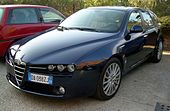
Alfa Romeo 159
Current mid-size saloon, introduced in production form at the 2005 Geneva Motor Show. The 159 is available with four different petrol engines and three diesels. 159 Sportwagon is estate version of this car and future Crosswagon will replace ageing 156 Crosswagon.

Alfa Romeo 166
Executive car produced by the Italian automaker Alfa Romeo since 1998. Production is slowly phasing out and replacement 169 is going to be released around 2009/2010. The 166 underwent a substantial revamp in 2003 and the styling was substantially altered.

Alfa Romeo GT
Front wheel drive small Bertone designed coupe. GT was introduced in 2004 and is based on the 156 sedan. Engine options includes two petrol and and one diesel version. Interior is based heavily on the 147. GT has two petrol and one diesel engine in model range.

Alfa Romeo Brera
The Brera originally appeared as a concept car at the 2002 Geneva Motor Show. Car is 2+2 seater coupe designed by Giorgetto Giugiaro and manufactured by Pininfarina. Car was originally introduced as a concept car at the 2002 Geneva Motor Show. Production version maintained the exterior appearance almost exactly but on a much smaller scale.

Alfa Romeo Spider
Roadster variant of Brera coupe was introduced at the 2006 Geneva Motor Show. Car replaced 1995 introduced Spider 916 model. Pininfarina is assembling this car alongside Brera in San Giorgio Canavese, Italy.
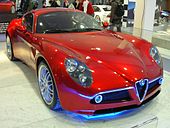
Alfa Romeo 8C Competizione
Limited edition supercar (500) presented as a concept car at the 2003 Frankfurt Motor Show and later released for sale for the 2007 model year. Car is using Ferrari/Maserati derived V8 engine, producing 450 PS.
Future models
- Alfa Romeo Junior (Expected-2007/2008)
- Alfa Romeo 149 (Expected-2008)
- Alfa Romeo 169 (Expected-2009)
- CXover (Expected-2009)
Old models





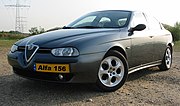
| Alfa Romeo Cars | |
|---|---|
| 1910 |
1910-1920 24 HP |
| 1920 |
1921-1922 20-30 HP |
| 1930 |
1931-1934 8C 2300 |
| 1940 | |
| 1950 |
1950-1958 1900 |
| 1960 |
1962-1968 2600 |
| 1970 |
1970-1977 Montreal |
| 1980 |
1983-1994 GTV6 |
| 1990 |
1992-1998 155 |
Concepts
Design has always played a large role in the history of Alfa Romeo. There has been many Alfa Romeo concept cars, made by famous design houses and designers. One being BAT a joint collaboration project with the Italian design house; Bertone. Also other famous Italian coachbuilders and design houses like Pininfarina, Bertone, Zagato and ItalDesign - Giugiaro have played a great role in Alfa Romeos history and even today some of models are designed and contructed by these great names.
Other production
Aircraft engines
Alfa Romeo engine was used on aircraft first time in 1910 at Santoni-Franchini biplane. [4] However it was in 1930s when Alfa engines were used in bigger scale; Savoia Marchetti SM.74, Savoia-Marchetti SM.75, Savoia-Marchetti SM.79, Savoia Marchetti SM.81, Cant Z506B Airone all used Alfa Romeo manufactured engines.[5] In 1931 was arranged an competiton where Tazio Nuvolari drove his Alfa Romeo 8C 3000 Monza against Caproni Ca.100 airplane,[6] the car won. Alfa Romeo built various aircraft engines in the World War II, most known was RA.1000 RC 41-I Monsone, a license version of Daimler-Benz DB 601. This engine made it possible to built efficient fighter aircrafts like Macchi C.202 Folgore to Italian army.
Trucks, light commercial vehicles


In 1930 Alfa Romeo presented a light truck in addition to heavy LKWs based to Büssing constructions.[7] In the Second World War Alfa Romeo built also trucks for the Italian army and later also for the German Wehrmacht. After the war commercial motor vehicle production was resumed. In co-operation with Fiat and Saviem starting from the 60's different light truck models were developed. The production of heavy LCVs was terminated in 1967. In Brazil the heavy trucks were built still few years under the label name a FNM (Fábrica Nacional de Motores). Later Alfa Romeo concentrated to the passenger car manufacturing. Company also produced trolleybuses, which were used by many cities in Italy.
LCVs
- Romeo (1954-1958)
- Romeo 2 (until 1966)
- Romeo 3 (1966)
- A11/F11
- A12/F12 (until 1983)
Trucks
- Alfa Romeo 430
- Alfa Romeo 500
- Alfa Romeo 800
- Alfa Romeo 900
- Alfa Romeo 950
- Alfa Romeo Mille (Alfa Romeo 1000)
Buses
- Alfa Romeo 900
- Alfa Romeo 950
- Alfa Romeo Mille (Alfa Romeo 1000)
Trolleybuses
- Alfa Romeo 110AF (1938)
- Alfa Romeo 140AF (1949)
- Alfa Romeo 900
- Alfa Romeo Mille (Alfa Romeo 1000)
See also
External links
Footnotes
- ^ italiaspeed.com]
- ^ "Saving Fiat", The Economist, December 3, 2005, p. 64, vol. 377.
- ^ autoweek.com
- ^ Borgeson, Griffith. The Alfa Romeo Tradition. ISBN 0-85429-875-4.
- ^ Alfa Romeo AEREI Collezione Modelli di Marco RigoniSettembre 2005
- ^ F-104 Starfighter (note Italian)
- ^ ALFA ROMEO TROLLEYBUSSES
